Introducing the SIT Furniture Design Award 2025 Catalogue, a collection of winning designs in furniture and interior design. This catalogue celebrates the winners of the 5th edition of the SIT Award, both established professionals and emerging talents showcasing their innovative creations and pushing the boundaries of form and function. Additionally, the catalogue features exclusive interviews with the “Designers of the Year”, offering unique insights into their creative processes and inspirations.
The catalogue is available to purchase on Amazon and can be downloaded on the SIT Furniture Design Award website.
Explore the future of design through the visionaries shaping it today!
A record-setting ceremony that brought together world-renowned studios, award-winning architects and a new generation of emerging designers for a night dedicated to creativity, collaboration and the future of design inside one of Basel’s most iconic cultural spaces.
On Friday, November 21st, 2025, Basel became the centre of the international design community as the SIT Furniture Design Award came together for their largest celebration to date. Two hundred guests from more than thirty countries, from China, Japan, Thailand, South Korea and Vietnam to the United States, Canada, Costa Rica, Argentina, South Africa and New Zealand, gathered inside the spectacular Elisabethenkirche, the 19th-century neo-Gothic landmark now transformed into one of Switzerland’s most striking contemporary cultural venues.
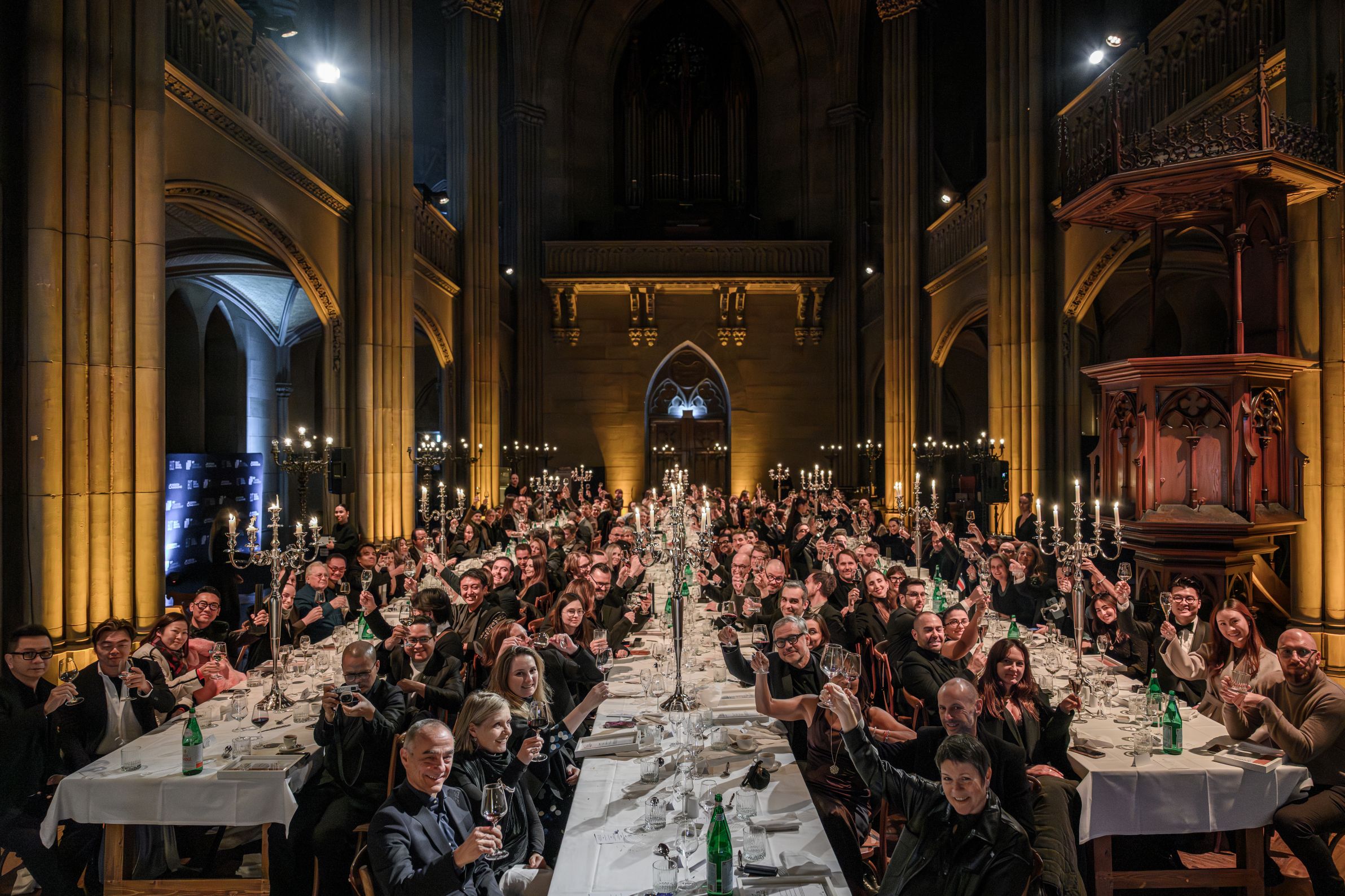
The decision to host the ceremony in the Elisabethenkirche underscored the awards’ shared values, honouring innovation, craftsmanship and adaptive reuse design at a moment when architecture and furniture design continue to respond creatively to the challenges of the built environment.
The evening brought together the winners of the 2024 and 2025 BLT Built Design Awards and the SIT Furniture Design Award, presenting both trophies and certificates on stage, accompanied by a seated gala dinner. Designers, architects, product innovators, academics, students, media partners and jury members connected throughout the evening, turning the neo-Gothic space into a lively international meeting point.
The ceremony was led by the 3C Group co-founders, Astrid Hébert and Hossein Farmani, who guided an extensive programme featuring some of the world’s most notable firms and emerging talents. Jury members joined them on stage to present the top-level trophies, including Pal Pang, London-based interior architect and artist and Chief Creative Officer of Another Design International; Dr. Anna Grichting Solder, Swiss architect, urbanist and musician with a Doctor of Design in Urbanism from Harvard; Andreas Rupf, Head of ETH RAUM at ETH Zürich and founder of SPEKTRUM GmbH, specialising in strategic spatial planning; Samantha Lassoudry, Founder & Chief Designer of Lassoudry Architects in Basel with a “custom-made couture” approach; Amir Idiatulin, Founder & CEO of IND (Russia/Global) and leader in architecture and urban strategy; Christian Brendelberger, Partner at Dietziker Partner Baumanagement AG and Head of Cost Planning on large-scale Swiss projects; and Alain Gilles, Brussels-based furniture and product designer, founder of The Studio and acclaimed internationally for his award-winning design work.
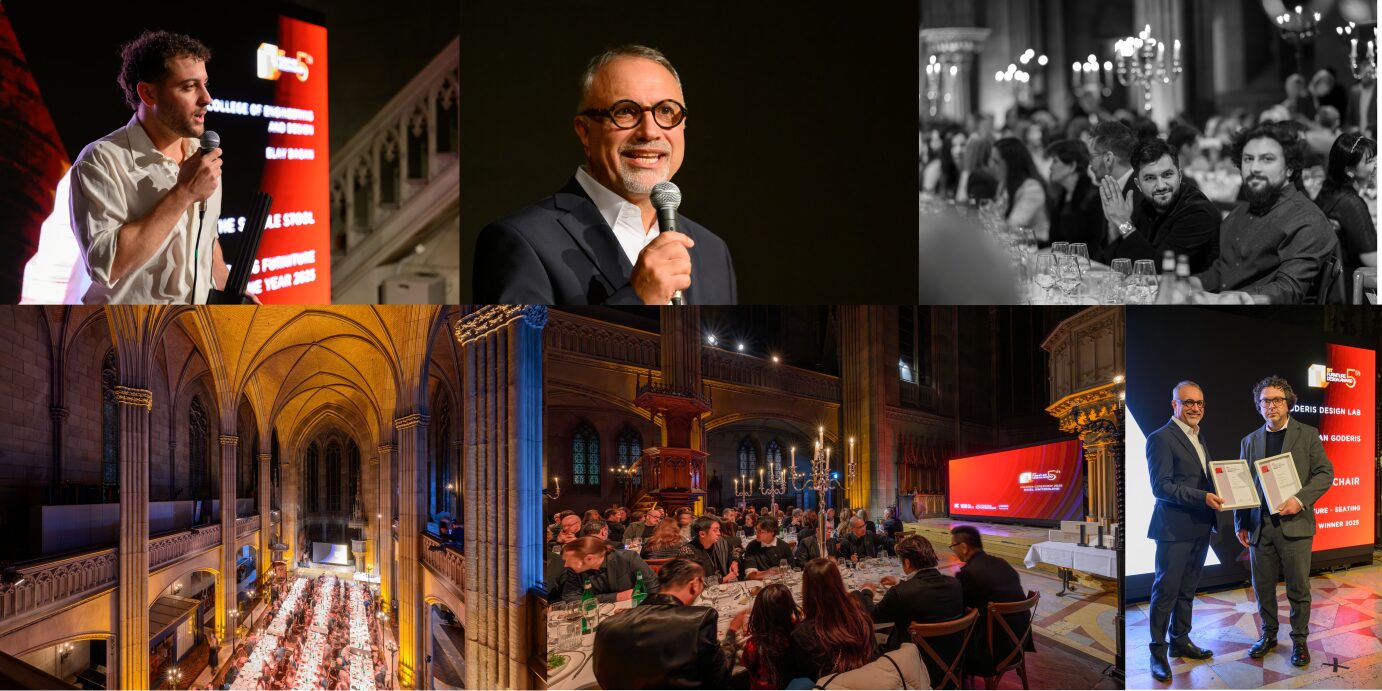
The SIT Furniture Design Award brought an equally global line-up, honouring ESCOFET, A-01 (A Company / A Foundation) and Shenkar College of Engineering and Design, alongside designers and studios such as Anna Lvovskaya of DA Bureau, Erick Martinez, HMN Handelsagentur, Studio Minus, Sila Yilmaz, Charles O. Job Design, Jan Goderis Design Lab, Franco Driusso of DAA DriussoAssociati Architects, Divan.ru, Olek Furniture, Raju Disain, Robert London Design, Klokner Institute at CTU in Prague, UDIT – Universidad de Diseño Innovación y Tecnología in Spain, ArtCenter College of Design, Howest Kortrijk, Queensland University of Technology, the Royal Danish Academy, Shih Chien University and the Faculties of Design represented by Filippo Sartori and Simone Codutti.
Students from fifteen universities were welcomed on stage throughout the evening, including Cape Peninsula University of Technology, Savannah College of Art and Design, Utah State University and Hochschule Koblenz, alongside previously mentioned institutions such as ETH Zürich, Bartlett School of Architecture at UCL, Shenkar College, UDIT, ArtCenter, Howest, Queensland University of Technology, the Royal Danish Academy and Shih Chien University, marking an extraordinary gathering of emerging designers and ensuring each university appeared only once across the ceremony.
Speaking about the scale of the evening, Astrid Hébert shared: “Standing inside the Elisabethenkirche and seeing designers, students and partners from all over the world gathered in one place was incredibly moving. Bringing the BLT Built Design Awards and the SIT Furniture Design Award together in this historic venue made the scale of the evening truly sink in, and I felt deeply grateful for the energy in the room and for everyone who travelled so far to celebrate with us at the biggest and most inspiring ceremony we have ever hosted.”
This year’s ceremony was supported by media partners including D5 MAG and v2com, marking another year of international collaboration and visibility for the award winners and their work. To explore the winning projects, keep up with upcoming deadlines or get involved in future editions, visit the official award websites and stay part of the global design community.

Public space feels most alive when it invites people to slow down, meet, and share moments together. This is what ESCOFET has been dedicated to for more than a century, shaping cities with urban elements that combine strength, function, and imagination. Their recent collaboration with Foster + Partners produced Gather and Tiers, two collections that prove concrete can be light, adaptable, and even welcoming.
Gather is designed as a modular system that creates small enclaves of privacy or generous stretches of seating, forming new ways for people to connect around greenery or in open plazas. Tiers adds another layer, with a collection of benches, stools, and tables at different heights that can be combined to suit work, relaxation, or social exchange. Both collections grew out of a close dialogue between Barcelona and London, with prototypes, models, and details refined until every curve and surface felt just right.
Honoured with Furniture Design of the Year at the SIT Furniture Design Awards, Gather and Tiers are turning concrete into places where urban life exists naturally, with ease and with purpose.
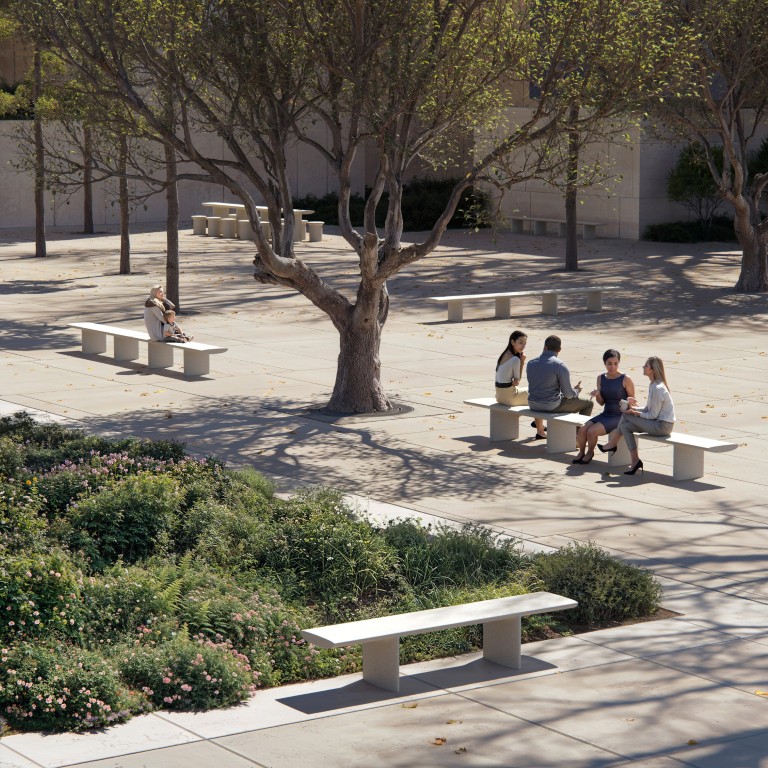
Photo Credit: HISM
Can you tell us a bit about the background of ESCOFET? And how did the collaboration with Foster + Partners come to be?
Escofet is a century-old company dedicated to transforming cities through the industrialisation of urban solutions, including benches, planters, and other elements. We are now part of the international cement group Molins. Our collaboration with Foster + Partners began through previous work with their architectural department, where we produced large concrete panels for a tower project in Warsaw. They were already familiar with our meticulous attention to detail in concrete industrialisation. Our relationship with the Foster + Partners Industrial Design team started with a meeting to discuss products needed for an urban project in London, which was not executed by us. From there, we started a good relationship, which ended up with the design of two collections of urban furniture elements to be included in our catalogue.
What would you say is the core design philosophy that guides ESCOFET?
We work closely with designers to ensure that proposals make a meaningful impact and generate value for society. Our commitment to material quality, functionality, and uniqueness is central to our philosophy. As concrete producers, we understand better than most how to leverage the material’s possibilities and benefits in design. Designing within the constraints of the material allows us to create truly distinctive pieces.
What was the inspiration for creating this type of modular, concrete-based urban furniture?
The inspiration was to create a social meeting point that encourages interaction among citizens. This concept led to the name and the concave module. With that solid foundation, developing a modular solution that allows designers to adapt and expand the system was a natural progression.
Could you walk us through the development process of Gather and Tiers?
The design process was both pleasant and inspiring. We maintained almost weekly contact with the Foster + Partners Industrial Design team. We began by defining the brief, validating concepts and usability through mockups and 3D models, checking ergonomics, and testing the material’s resistance.

Foster + Partners Industrial Design Team
What were some of the most significant challenges you faced during this project?
One major challenge was adapting the bench’s ergonomics to comply with different legal standards across various countries. Additionally, we focused heavily on perfecting details such as section transitions and surface connections, which required extensive work and collaboration.
This project rethinks how we interact with public space, both physically and socially. How important is that social component when designing urban furniture?
It is extremely important. As part of our strategy, We Love the City, we aim to promote a more vibrant, playful, and sustainable urban environment. We strive to create spaces that foster social connections and development, while also addressing environmental concerns.
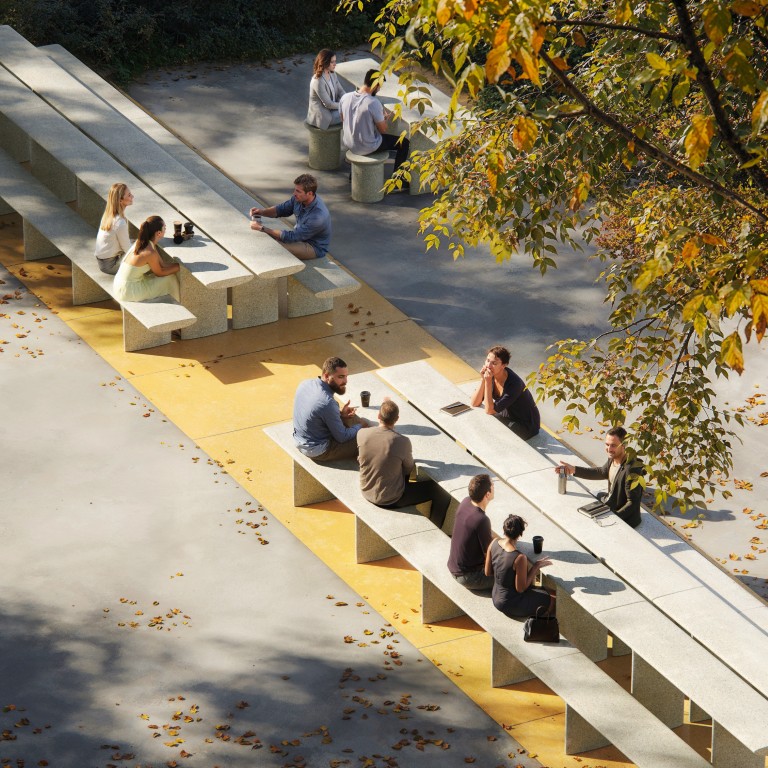
Photo Credit: HISM
Congratulations on winning Furniture Design of the Year at the SIT Awards! What does this award mean to your team?
It represents relevance and brand positioning. We are very grateful and proud to have the opportunity to share our product with the world.
Looking ahead, what do you envision for the future of your studio? Are there new materials, typologies, or urban needs that you’re especially interested in exploring?
We aim to grow by providing innovative urban solutions and addressing the consequences of climate change, such as rising temperatures, which compel us to create climate shelters. We are exploring the use of lighter colours and incorporating recycled aggregates into our concrete mixtures to face these challenges.
The SIT Furniture Design Award has announced the date and location of its annual awards ceremony and gala dinner, set for Friday, November 21st, 2025, in Basel, Switzerland, a city internationally recognized for its architectural heritage and vibrant cultural scene.
This year’s ceremony will be held at the Elisabethenkirche, a 19th-century neo-Gothic church that has been transformed into a contemporary cultural venue. The choice of location reflects the award’s core values, celebrating innovation while honoring tradition, and speaks directly to one of today’s most pressing design topics: adaptive and reuse design.
The evening will highlight the achievements of the 2024 and 2025 SIT Award winners, with formal trophy presentations, a seated gala dinner, and an exhibition of winning projects. Attending winners will be invited on stage to receive their certificates, while also enjoying the opportunity to connect with fellow designers, jury members, media, and the organizing team.
Each winning firm will receive two complimentary tickets to attend the event. The reservation platform will open in August, with more details to follow.
As one of the key international recognitions in the field of furniture and interior design, the SIT Award Ceremony 2025 is expected to gather leading voices and emerging talents from across the globe for an evening dedicated to design excellence and creative exchange.
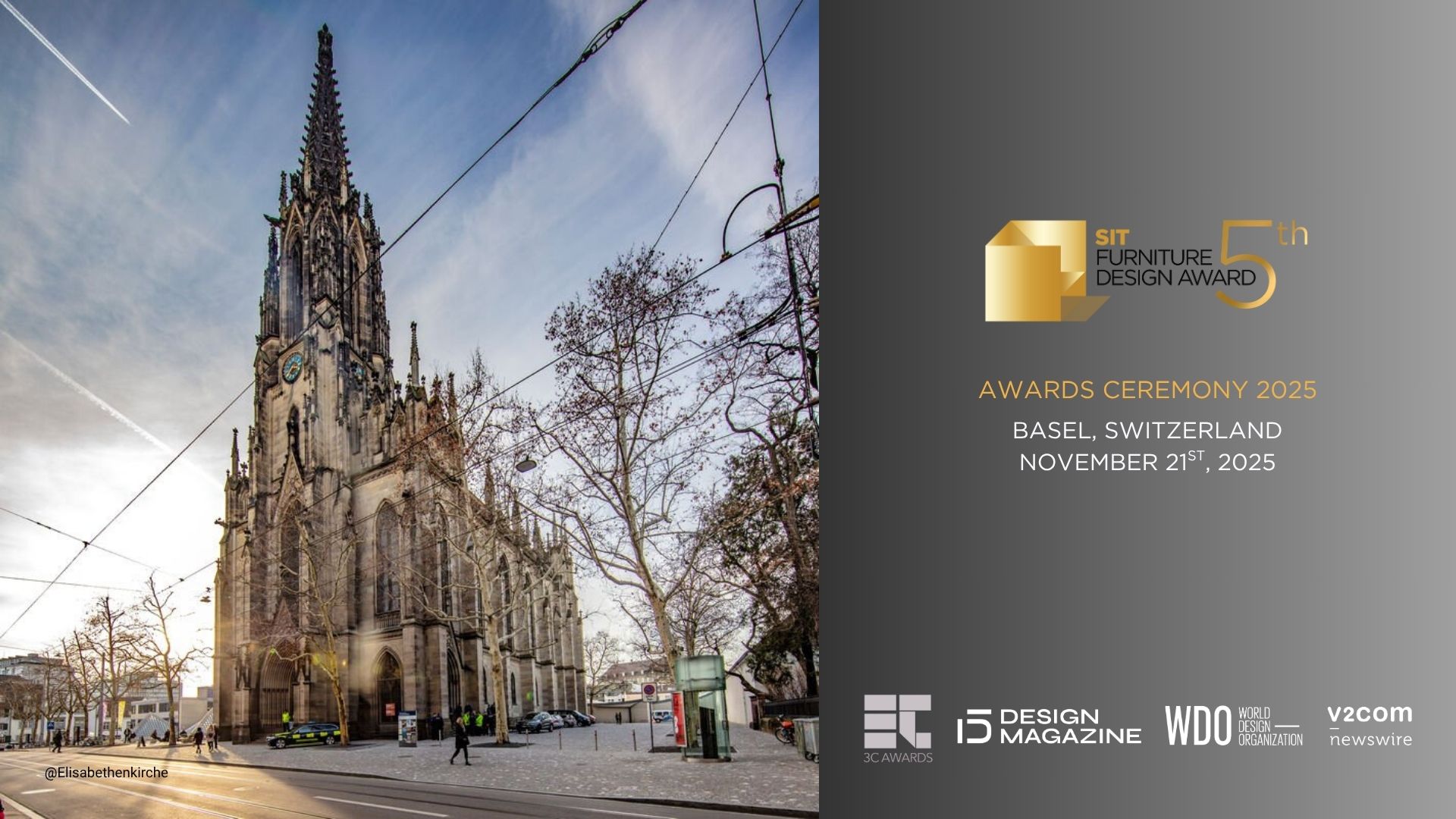
The Saddle Stool curves, folds, and flows like it’s in motion, even when perfectly still. Crafted from humble birch wood, it feels anything but rigid. There’s a tension to it, a softness carved out of something solid.
We spoke with designer Elay Dagan, winner of the SIT Furniture Design Award for Emerging Furniture Designer of the Year, about how this sculptural piece came to life. From experimenting with scraps in his home workshop to learning when to stop refining, Elay shares how the stool took shape, what drives his design approach, and why the space around the object matters just as much as the object itself.
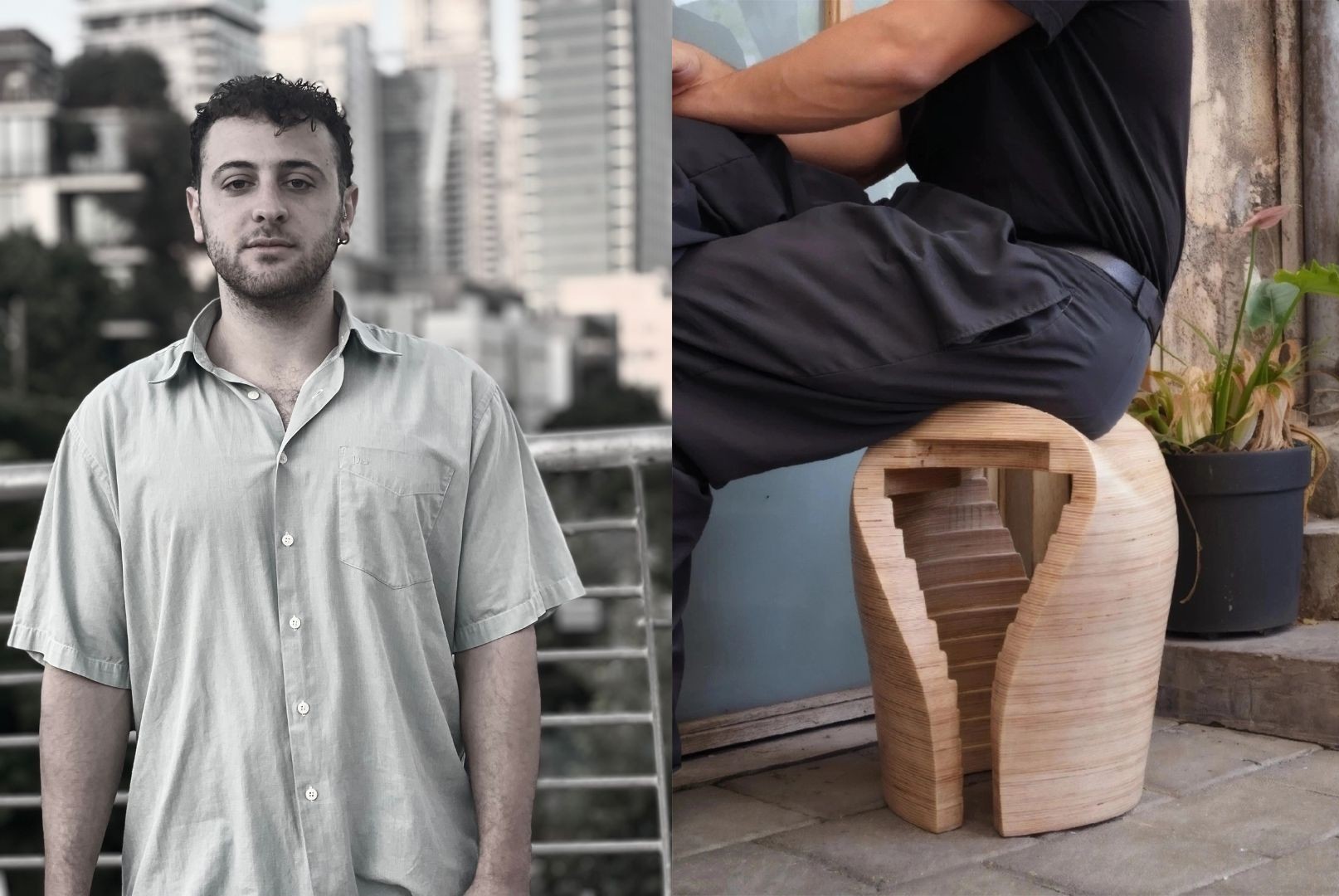
My name is Elay, I’m 25 years old. I was born and raised in Tel Aviv—a city I truly love. It gave me space, freedom, the sea, and interesting people. I’m the eldest in my family, with two younger sisters, and I grew up in a house that was always in motion. My father is a construction project manager, and my mother is an industrial designer. We did almost everything ourselves at home—fixing, building, painting, even moving walls.
I was never sure I would pursue academic studies. At first, I thought I would simply become a craftsman—learning through hands-on experience. I worked in a carpentry shop as an apprentice, and later began working with Eden, an extraordinary sculptor who specializes in concrete restoration. We created textures for public buildings, cast benches and sinks, and restored historic structures. Every day, I learned something new.
The turning point came when I began leading recycling workshops. That’s where I met a friend who was then my partner—she was studying industrial design. One day, she simply decided to sign me up for the Shankar entrance exams, without telling me. When the brief arrived, I sat down at the table—and didn’t get up. I felt a kind of inner storm, almost like a revelation. I realized that this is what I want to do—to design.
Today, when I reflect on my design approach, I feel it constantly moves along the axis between technology and craftsmanship. I’m deeply curious about new technologies, software, and digital tools. I love to explore, learn, and dive deep into anything related to advanced and precise production. At the same time, I believe in the power of human touch. For me, the soul of an object comes from the material itself—from the small scratch, the imperfect edge, and the traces left by the hands that shaped it. That’s what gives an object life and character.
This connection—between mechanical precision and the sensitivity of handcrafted work—is at the heart of what I strive for. Sometimes I approach a material and begin working without overthinking it, simply letting my hands lead the way. Most of the time, they know what to do—and they take me exactly where I need to go.
I created the stool during a design course at the end of my first year. The course aimed to explore materials—how to bend them, cut them, use their properties, and experiment with alternative approaches.
As a personal challenge, I decided to work only with what I already had in my small home workshop—without rushing out to buy new materials. I found scraps of leather, cardboard, paper, and oak veneer, and started combining, gluing, cutting, and bending them. Then, at the end of a long workday, just as I was about to turn off the light, I took a piece of veneer, folded it, added a screw—and suddenly everything clicked. A gesture emerged that I hadn’t planned, but I immediately felt it was the one. That moment, when a simple material bends and becomes something else, is what pushed the entire project forward. I knew I wanted to develop and preserve that exact quality.
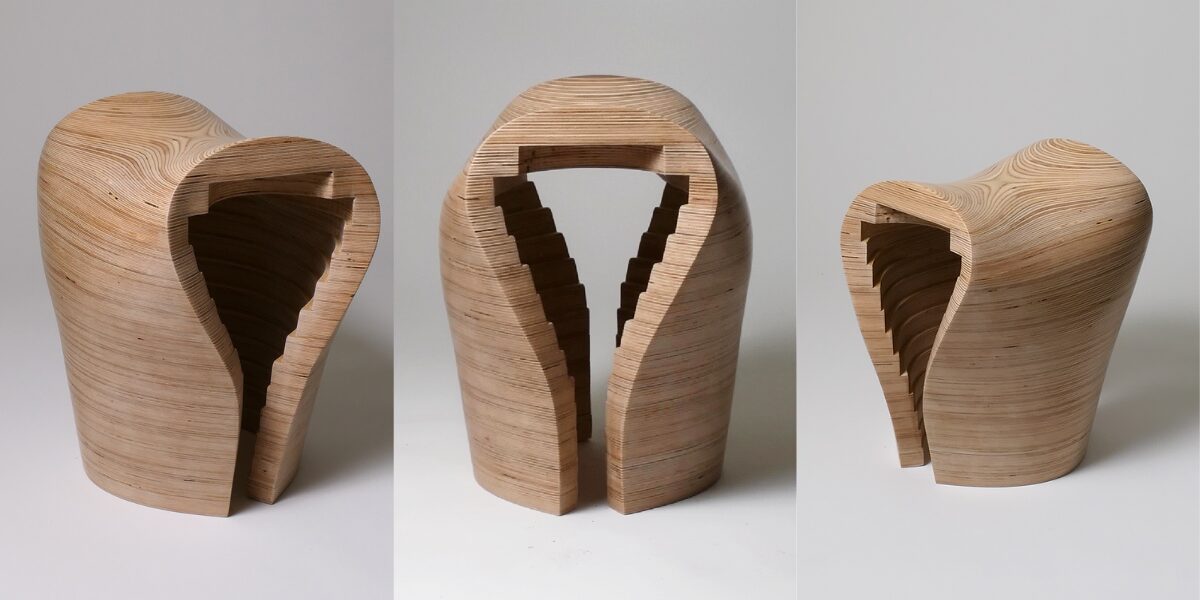
The stool’s design expresses motion and flow—rooted in early experiments with bending soft, lightweight, linear materials at a 1:10 scale. At first, I looked for a material that could mimic the thinness of paper but remain strong and durable enough to function as a stool.
Ironically, the breakthrough came when I gave up and decided to express that same movement using a rigid and static material. That choice created a surprising contrast, infusing the project with softness, elegance, and intrigue.
As I continued working, I realized that spatial movement—the air surrounding and within the object—was just as compelling. The void became a material of its own: an active element that “breathes,” envelops, and lends the stool its dynamic energy. The internal volume—the emptiness—became an integral part of the form.
I chose birch wood—a simple, accessible, and relatively inexpensive material—and through sculptural handwork, transformed it into something unique and refined. I deliberately left the interior raw and unfinished, as a tribute to the production process, which combined advanced CNC milling with the immediacy of handcraft. This fusion—between the innovative and the traditional—is, in my view, what gives the stool its modern and vibrant character.

The biggest challenge for me was reaching the point where I truly felt at peace with what I had created. I had countless sketches, each of which could have led in a different direction. I worked under tight deadlines—it was a short project, with a clear finish line—and there was a constant sense of urgency, a need to make final decisions quickly.
Choosing the production method and material was a turning point—I felt it in my body. A kind of internal quiet that signaled: this is it. From that moment on, all the other pieces started falling into place.
Of course, even after that, I faced many crossroads and critical decisions at nearly every stage. Eventually, I realized I needed to stop. Not to overwork. Not to over-polish. To leave it rough where it needed to be—not perfect, but alive. To listen to what the project wanted to become—and let it lead me.
Winning the competition was an incredibly emotional moment for me. At first, I couldn’t quite believe it was real—but when I saw the official announcement, the feeling started to sink in.
The award gave me a deep sense of confidence. It helped me understand that I have a voice, that I have something to say—and that voice is being heard, and it matters. It connected my inner passion with external validation, and gave me a small but powerful sign that I may be on the right path.
I dream of a large workshop filled with all kinds of machines—old and cutting-edge—that allow me to move between worlds and merge material with technology. More than anything, I’d love to work there alongside friends and colleagues—curious people like me, each bringing something different to the table.
And my biggest dream? To present a series of works in a gallery or museum. To create projects that provoke thought, touch people, and tell stories through material, structure, and form. To exist in the space where design meets people and art.
And finally—I want to thank you for this special opportunity, for the recognition and the honor—it’s incredibly meaningful to me. I also want to thank my teachers at Shankar, who guided me, challenged me, and asked the right questions. And a huge thank-you to everyone who supported, helped, and stood by me—you are an inseparable part of this journey, and of this success.
From bioclimatic interiors that breathe with the forest to sculptural seating shaped by ultra-performance concrete, this year’s winners reflect the bold, the functional, and the visionary.
We’re excited to announce the winners of the SIT Furniture Design Award 2025 and even more thrilled to celebrate our fifth edition! With over 400 submissions from 44 countries, this year’s awards highlight the designers and studios rethinking how we sit, live, rest, and relate to the spaces around us. From inventive interiors to standout outdoor concepts, the selected works reflect a thoughtful and inspired approach to design today.
Let’s take a look at this year’s main winners — the projects that truly stood out:
The Interior Designer of the Year award goes to A-01 (A Company / A Foundation), a practice based in both Costa Rica and the Netherlands, for their No Footprint Wood House. Perched along the lush Pacific coast, this bioclimatic structure goes far beyond aesthetics. It blends with its jungle setting, breathes with the landscape, and functions as both a home and a prototype for regenerative design.
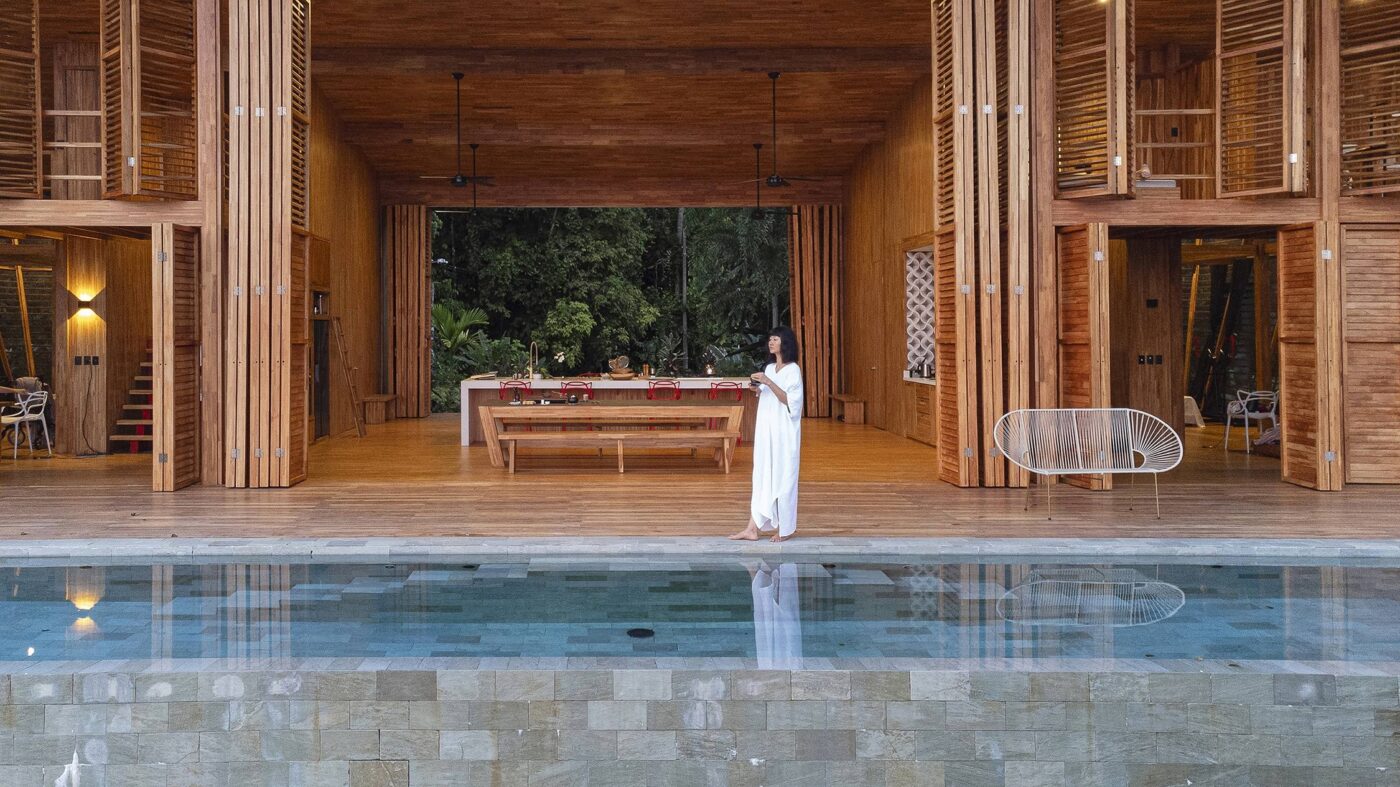
No Footprint Wood House by A-01 (A Company / A Foundation)
In the Furniture Design of the Year category, Foster + Partners won for Gather and Tiers, two sculptural collections developed with Barcelona-based concrete experts ESCOFET. Made from ultra-high-performance concrete, these public seating systems offer privacy and flexibility, inviting us to reclaim the outdoors with elegance and intention.
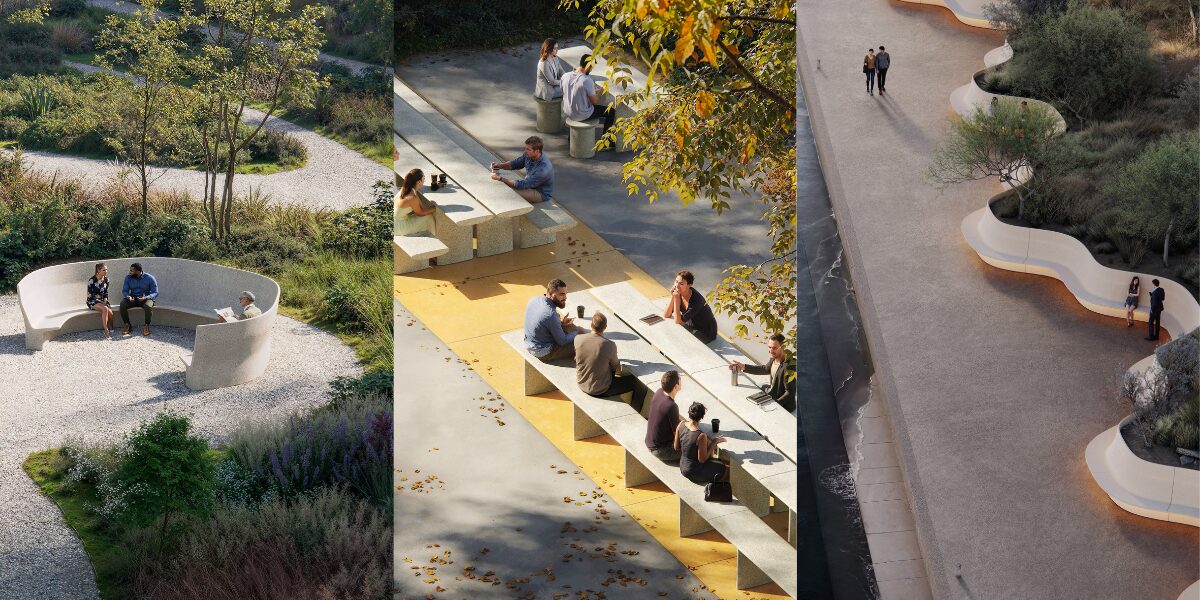
Gather and Tiers by Foster + Partners
Emerging talent is equally celebrated. The Emerging Furniture Designer of the Year title goes to Elay Dagan for The Saddle stool, a sculptural object that captures the illusion of softness within a rigid material. The piece, born of experimentation with movement and material tension, plays with space as much as form.

The Saddle stool by Elay Dagan
Alongside these headlining honors, this year’s competition welcomed an exceptional variety of standout designs: from the serene Floating Bed by Winzeler Holzdesign to the rippling concrete forms of TOPOS Outdoor Furniture Collection by Zaha Hadid Architects. Other highlights include the playful Biscuit armchair by WOWIN.UA, the elegant Ribbon Desk by Scot Distefano, and Canopy House by Studio Mk27.
The selection was made by a prestigious international jury of designers, architects, and educators, including Lilian González-González, Alain Gilles, Nima Bavardi, Christina Chen-Chiao Kuo, Bo Zhang, Richie Moalosi, Fereshteh Haji Gholami, and Javier Palomares, to name only a few. Their collective expertise reflects the award’s global scope and growing impact in shaping design dialogue across continents.
“We created the SIT Furniture Design Award to celebrate excellence in this often-overlooked but fundamental design discipline,” says Astrid Hébert, Co-Founder of the Awards. “What’s truly exciting this year is the extraordinary range, from iconic studios like Foster + Partners and Zaha Hadid Architects to promising new voices like Elay Dagan. It’s a sign that SIT is no longer a niche platform; it’s becoming a key destination for discovering what’s next in furniture and interior innovation.”
As the industry continues to blur the lines between architecture, product, and spatial design, SIT remains a vital platform for designers whose work speaks not just of objects, but of how we inhabit the world. For the complete list of winners and jury bios, visit www.sitaward.com.
The SIT Furniture Design Award, a prestigious platform celebrating excellence in furniture design, is thrilled to announce the addition of three acclaimed design leaders to its distinguished jury: Fereshteh Haji Gholami, Richie Moalosi and Javier Palomares. Their expertise and global perspectives further strengthen the award’s mission to champion creativity, innovation, and accessibility within the international furniture design community.
Fereshteh Haji Gholami is an award-winning architect, interior designer, and university lecturer with an impressive track record of 13 international design awards. She holds a degree in Architecture and Sustainable Design from UPM University in Malaysia and is the founder of KIOSKedia International Academy and KIOSK International Magazine. Her design expertise spans architecture, interior design, furniture, and lighting product design.. A passionate advocate for sustainable design, Fereshteh conducts research on energy efficiency and environmentally responsible architecture and industrial design. She also leads international workshops, seminars, and exhibitions, promoting design excellence worldwide.
Richie Moalosi is a Professor of Industrial Design and the founding Director of the Innovation Centre at the University of Botswana. With over 20 years of teaching experience and a PhD in Industrial Design from the Queensland University of Technology in Australia, Moalosi brings deep expertise in design and cultural innovation. Moalosi collaborates with small businesses, creative industries, and start-ups, helping them develop products, brands, and innovative services – key drivers of the creative economy in Africa and beyond. An accomplished author and speaker, Moalosi has published extensively in international peer-reviewed journals and presented at leading design conferences. He is a fellow of the Pan Afrikan Design Institute and serves as an advisor to the Don Norman Design Awards.
Javier Palomares, based in Pasadena, is the Principal of Curve Ahead Design and a Professor of Product Design at ArtCenter College of Design. A graduate of ArtCenter, he blends craftsmanship with innovation in his work, which has been showcased at events such as High Point Market and Dwell on Design. His conference table design earned Gold at NEOCON, one of the industry’s most prestigious honors. Javier is also passionate about incorporating Artificial Intelligence into design, exploring its potential in prototyping and material visualization. Alongside his practice, he mentors graduate students at ArtCenter, encouraging a human-centered approach to design.
They are joining an already stellar jury featuring Alain Gilles, Founder and Lead Designer at Alain Gilles The Studio, Christina Chen-Chiao Kuo, Creative Director and Founder of Kuuo Living Limited, Bo Zhang, Artist and Chief Designer at Desz Office, Niko Kapa, Design Director of Studio Niko Kapa, Steven Yeung, Founder of Kar, Zhou Yi, Chief Designer at Dayi Design, Lilian González-González, Industrial Design Academic Coordinator at Anáhuac University and Board Member at the World Design Organization, Jing Ju, Design Director at JUJU Studio, Nima Bavardi, Head of Industrial Design Department at KIOSKedia International Academy and Magazine, Stella Hernandez, Assistant Professor in the Environmental Design Department at ArtCenter College of Design, Robyn Self, Founder and Director of Plan-IT Design and IID – The African Institute of the Interior Design Professions, Christoph Guenther, Product and Interior Designer at Dutch East Design, and Sébastien Maleville, Co-Founder and Creative Director at Essential Studio. A full list of the distinguished jury can also be viewed on the website.
“We’re thrilled to welcome Fereshteh, Richie and Javier to the jury,” says Astrid Hebert, Program Director of the SIT Furniture Design Award. “Their global outlook and design expertise will be invaluable in recognizing the most creative and innovative furniture designs. This year’s competition is shaping up to be truly remarkable!”
The SIT Furniture Design Award is now accepting submissions for its annual competition – but time is running out. Furniture designers at every stage of their career are encouraged to submit their work by April 20, 2025. Don’t miss this chance to gain global recognition – visit the sitaward.com to learn more and apply today.
Introducing the SIT Furniture Design Award 2024 Catalogue, a collection of winning designs in furniture and interior design. This catalogue celebrates the winners of the fourth edition of the SIT Award, both established professionals and emerging talents showcasing their innovative creations and pushing the boundaries of form and function. Additionally, the catalogue features exclusive interviews with the “Designers of the Year”, offering unique insights into their creative processes and inspirations.
The catalogue is available to purchase on Amazon and can be downloaded on the SIT Furniture Design Award website.
Explore the future of design through the visionaries shaping it today!
SIT Furniture Design Award, a prestigious international platform dedicated to celebrating brilliance in furniture design and Interior Design, is delighted to announce that submissions for its 5th edition are now open. With a global reach and a mission to recognize, celebrate, and promote exceptional furniture maker, interior designers, brands, manufacturers, emerging talents, and visionaries, the Award honors those who enhance our daily lives with their vision. Focusing on the concept of “Seat and Beyond,” the SIT Furniture Design Award celebrates the strategic thinking, imagination, and creativity that are instrumental in crafting remarkable furniture pieces. Encouraging designers to push the boundaries of design and explore new possibilities, this program sets the stage for global recognition and appreciation of exceptional talent.
“Awarding excellence in furniture and interior design, we’re thrilled to announce the 5th edition of the SIT Furniture Design Award,” said co-founder Astrid Hebert. “With over 400 outstanding submissions last year, we can’t wait to see this year’s entries, especially those championing sustainability. We look forward to celebrating innovative, eco-conscious designs that inspire the future of our industry.”
The jury panel of the SIT Furniture Design Award is composed of influential professionals renowned in the global design community. Alain Gilles, Founder and Lead Designer at Alain Gilles The Studio, brings his innovative approach, while Bo Zhang, Artist & Chief Designer at Desz Office, contributes his visionary perspective. Niko Kapa, Design Director at Studio Niko Kapa, offers his expertise, alongside Christina Chen-Chiao Kuo, Creative Director & Founder of Kuuo Living Limited, Nataly Bolshakova, Founder and Lead Designer of Bolshakova Interiors, Steven Yeung, Founder of Kar, and Zhou Yi, Chief Designer at Dayi Design. Lilian González-González, Industrial Design Academic Coordinator at Anáhuac University of México and Board Member of the World Design Organization, enriches the panel with her academic and international perspectives. These experts, alongside other distinguished members, bring a wealth of experience and diverse perspectives to ensure a thorough evaluation and recognition of excellence in furniture and interior design.
The award is open to submissions on a global level, welcoming entries from designers and emerging talents from all corners of the world. Whether conceptual designs, works in progress, or completed projects, SIT Furniture Design Award invites professionals and students alike to showcase their vision and craftsmanship.
To seize this exciting opportunity, designers are encouraged to submit their entries before the September 8th, 2024 early bird deadline and enjoy a 10% discount, making it the perfect chance to showcase their remarkable designs at reduced costs. From seating and lighting to tables, homeware, and outdoor furniture, the award celebrates diverse design expressions. For further details regarding the submission process, evaluation criteria, and important dates, please visit the SIT Furniture Design Award website at sitaward.com.
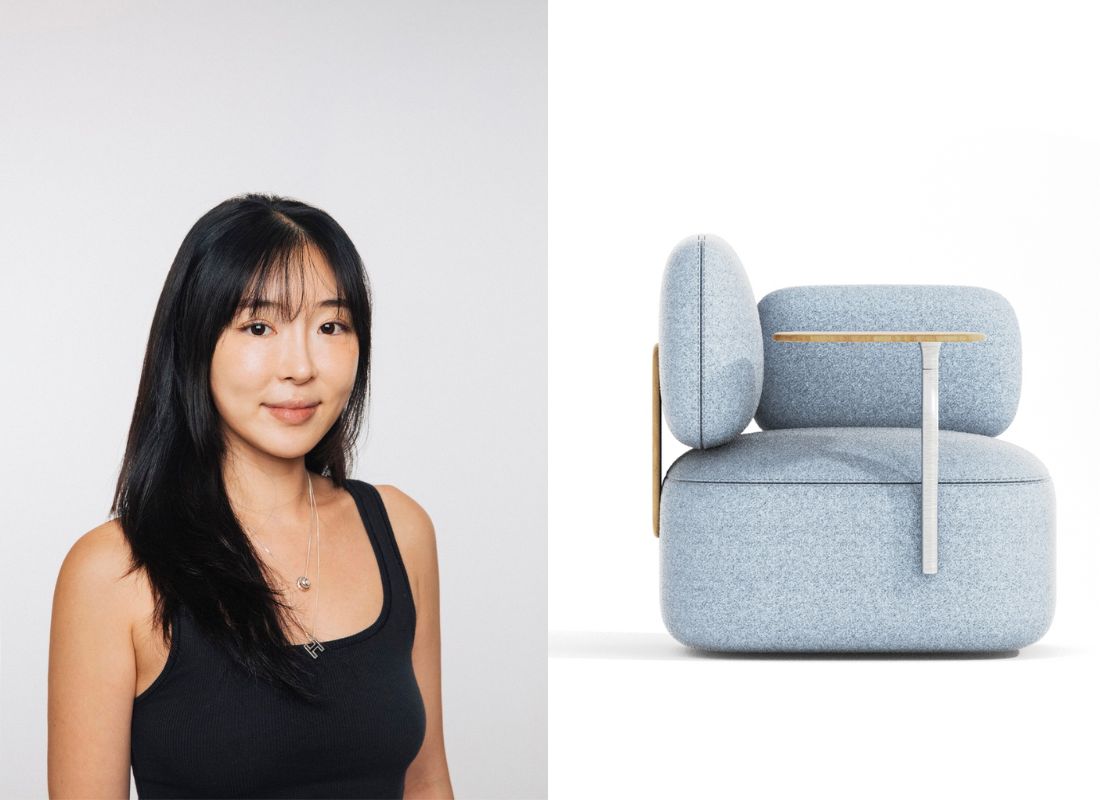 Can you tell us a bit about yourself and your background? How did design come to have such an important place in your life? I graduated from Art Center College of Design last year, and currently, I work as an industrial designer based in the Bay Area. Before delving into industrial design, I spent a year studying fashion design, which has deeply influenced my approach to product design. My understanding of color and materials stems from my foundation in fashion. Growing up, my mother ran an art academy where I was exposed to numerous drawings and paintings. We often drew together, forging a strong bond that made art a meaningful part of my life. This experience inspired me to aspire to design products that evoke positive memories, carry profound meaning, and endure over time. Can you elaborate on the concept behind the design of the Otto Lounge Chair? With the shift towards remote and hybrid work becoming the norm, the boundaries between work and personal life have become less clear. I aim to integrate elements that evoke warmth, comfort, and a sense of home into office environments, thereby enhancing the workplace experience. On the other hand, for home settings, I propose solutions that support efficiency and productivity, addressing the common challenges of distractions that often accompany remote work. Can you walk us through the design process? How did the design evolve from your initial idea to the final product? I had initially considered creating furniture suitable for both office and home environments. However, I ultimately decided to move forward with designing a multi-functional lounge chair that could seamlessly transition between these two settings. The initial sketch lacked the soft curvature and cushioning I envisioned, so I dedicated considerable effort to refining its form. This process began with a small-scale cardboard mock-up and progressed to a precise 3D-milled prototype to achieve the desired shape. I particularly focused on ensuring that the wooden elements connecting the cushion and table components complemented the overall design cohesively. How does the Otto Lounge Chair address the need of hybrid living spaces in a post-pandemic world? Otto is a versatile lounge chair designed to offer comfort and functionality that align with evolving lifestyles. With more people working from home and blending their living and working spaces, Otto serves as a multi-functional piece of furniture. Its pivot table feature makes Otto ideal for adapting to the flexible and multifaceted demands of hybrid living spaces, where seamless transitions between work and relaxation are increasingly important. Can you discuss the pivoting table feature and how it perfectly incorporates user needs into the design? The pivot table is a pivotal feature of Otto, carefully tailored to meet user needs. This feature enables Otto to function as a compact workspace for laptops or documents, enhancing productivity in home office settings. What sets it apart is its dual functionality—it can also function as an armrest when not actively in use.
Can you tell us a bit about yourself and your background? How did design come to have such an important place in your life? I graduated from Art Center College of Design last year, and currently, I work as an industrial designer based in the Bay Area. Before delving into industrial design, I spent a year studying fashion design, which has deeply influenced my approach to product design. My understanding of color and materials stems from my foundation in fashion. Growing up, my mother ran an art academy where I was exposed to numerous drawings and paintings. We often drew together, forging a strong bond that made art a meaningful part of my life. This experience inspired me to aspire to design products that evoke positive memories, carry profound meaning, and endure over time. Can you elaborate on the concept behind the design of the Otto Lounge Chair? With the shift towards remote and hybrid work becoming the norm, the boundaries between work and personal life have become less clear. I aim to integrate elements that evoke warmth, comfort, and a sense of home into office environments, thereby enhancing the workplace experience. On the other hand, for home settings, I propose solutions that support efficiency and productivity, addressing the common challenges of distractions that often accompany remote work. Can you walk us through the design process? How did the design evolve from your initial idea to the final product? I had initially considered creating furniture suitable for both office and home environments. However, I ultimately decided to move forward with designing a multi-functional lounge chair that could seamlessly transition between these two settings. The initial sketch lacked the soft curvature and cushioning I envisioned, so I dedicated considerable effort to refining its form. This process began with a small-scale cardboard mock-up and progressed to a precise 3D-milled prototype to achieve the desired shape. I particularly focused on ensuring that the wooden elements connecting the cushion and table components complemented the overall design cohesively. How does the Otto Lounge Chair address the need of hybrid living spaces in a post-pandemic world? Otto is a versatile lounge chair designed to offer comfort and functionality that align with evolving lifestyles. With more people working from home and blending their living and working spaces, Otto serves as a multi-functional piece of furniture. Its pivot table feature makes Otto ideal for adapting to the flexible and multifaceted demands of hybrid living spaces, where seamless transitions between work and relaxation are increasingly important. Can you discuss the pivoting table feature and how it perfectly incorporates user needs into the design? The pivot table is a pivotal feature of Otto, carefully tailored to meet user needs. This feature enables Otto to function as a compact workspace for laptops or documents, enhancing productivity in home office settings. What sets it apart is its dual functionality—it can also function as an armrest when not actively in use. 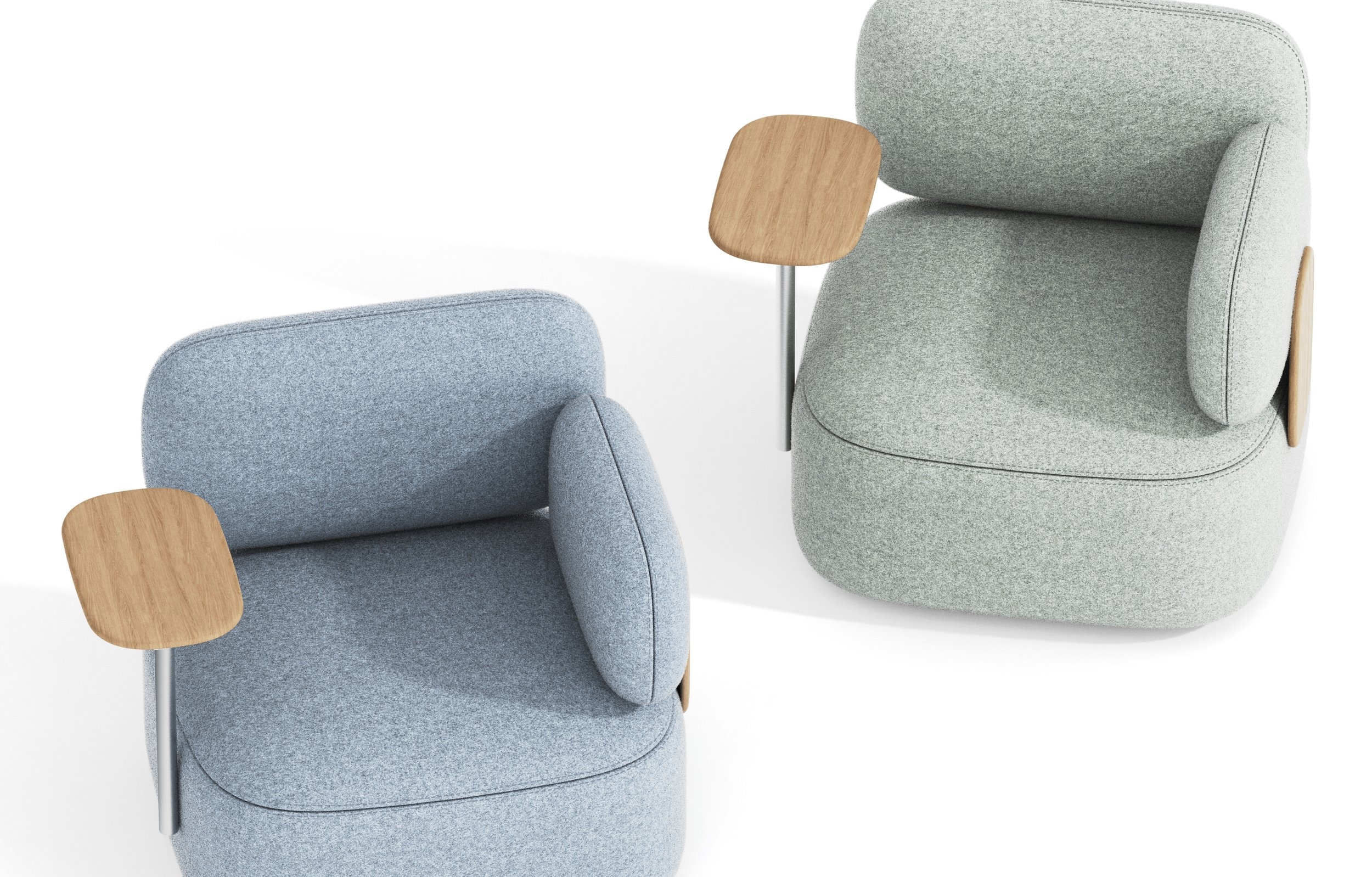 Can you elaborate on the choice of materials and how they made the cut? I believe the standout feature of Otto lies in the wooden pieces that connect the cushions. I aimed to select a material that could not only create iconic pieces but also harmonize with any environment. Therefore, wood was a natural choice due to its ability to blend seamlessly into various spaces. These pieces were CNC milled to achieve the precise forms required. What were some of the challenges you faced while designing the Otto Lounge Chair? What did you learn from the process? Of course, I spent a lot of time refining the proportions. Since this was my first experience making furniture, I initially lacked knowledge of furniture construction. However, with excellent guidance from class instructors, I learned how to construct and assemble a frame structure. Furthermore, through communication and learning from upholsterers, I was able to overcome these challenges. Congratulations on winning the SIT Emerging Furniture Designer of the Year award! What is next for you and your studio? Are there any new designs you’re working on that you can tell us about? Thank you! It’s truly an honor to win the award, especially the title of Emerging Furniture Designer of the Year. Since graduating, I’ve been gaining valuable experience at a design agency, where I’ve had the opportunity to work on various products. While I don’t have immediate plans for new designs, I look forward to pursuing personal projects in the future, where I can apply the skills I’ve acquired in the industry so far. Please stay tuned for what’s to come. What advice would you offer to new designers entering the field? Since there are tons of furniture out there, With countless furniture options available, it’s essential to think about how your design can be differentiated from the other. As a designer, I believe it’s crucial to not only focus on aesthetic appeal but also to understand and cater to the evolving behaviors and environments of people. Learning from others and asking as many questions as possible are invaluable in this process. I continue to learn new things every day, recognizing that learning is a continuous journey without end. VIEW ALL WINNERS.
Can you elaborate on the choice of materials and how they made the cut? I believe the standout feature of Otto lies in the wooden pieces that connect the cushions. I aimed to select a material that could not only create iconic pieces but also harmonize with any environment. Therefore, wood was a natural choice due to its ability to blend seamlessly into various spaces. These pieces were CNC milled to achieve the precise forms required. What were some of the challenges you faced while designing the Otto Lounge Chair? What did you learn from the process? Of course, I spent a lot of time refining the proportions. Since this was my first experience making furniture, I initially lacked knowledge of furniture construction. However, with excellent guidance from class instructors, I learned how to construct and assemble a frame structure. Furthermore, through communication and learning from upholsterers, I was able to overcome these challenges. Congratulations on winning the SIT Emerging Furniture Designer of the Year award! What is next for you and your studio? Are there any new designs you’re working on that you can tell us about? Thank you! It’s truly an honor to win the award, especially the title of Emerging Furniture Designer of the Year. Since graduating, I’ve been gaining valuable experience at a design agency, where I’ve had the opportunity to work on various products. While I don’t have immediate plans for new designs, I look forward to pursuing personal projects in the future, where I can apply the skills I’ve acquired in the industry so far. Please stay tuned for what’s to come. What advice would you offer to new designers entering the field? Since there are tons of furniture out there, With countless furniture options available, it’s essential to think about how your design can be differentiated from the other. As a designer, I believe it’s crucial to not only focus on aesthetic appeal but also to understand and cater to the evolving behaviors and environments of people. Learning from others and asking as many questions as possible are invaluable in this process. I continue to learn new things every day, recognizing that learning is a continuous journey without end. VIEW ALL WINNERS.